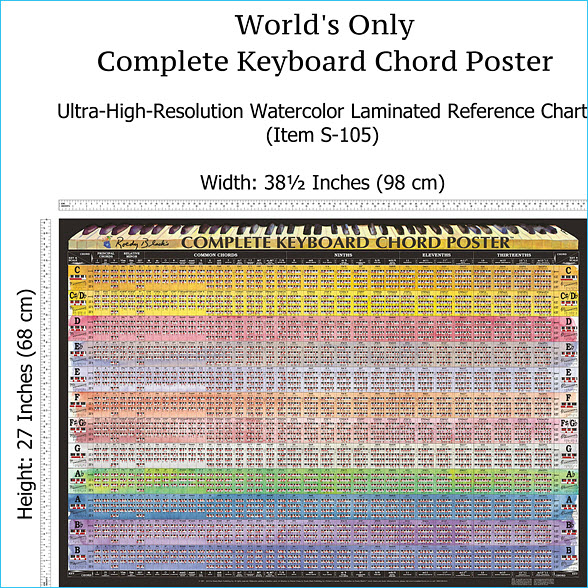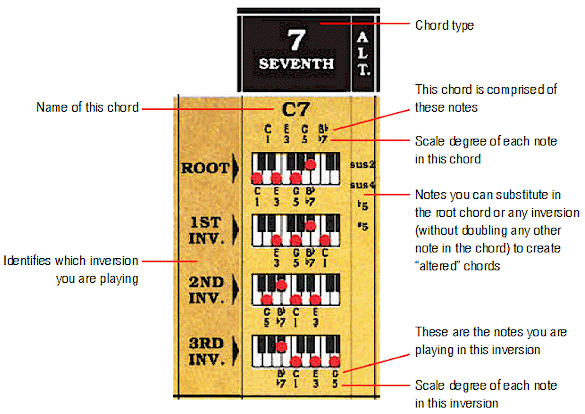|
|

AVAILABLE in Three Formats:
|
|
|
ABOUT
THE
COMPLETE
KEYBOARD
CHORD
POSTER
The Complete
Keyboard Chord Poster shows the fingering positions of every keyboard
chord, including the inversions. Players at all levels,
from beginner to advanced, can take advantage of this chart’s unique
features.
-
Beginners—The
chart shows chord diagrams for all the simple, basic chords in
all major and minor keys. The poster also includes major scales for each
key (left and right margins).
-
Intermediate-level players—As you move from left to right across the
poster, chords become progressively more “advanced.” This makes it easy
for you to learn new, unusual chords and chord inversions at your own
pace, without losing track of your progress. Color bands make it easy to
identify each key, and to quickly transpose the chords of a song from any
key to any other key.
-
Advanced
players—Even the most expert players usually don’t have all chords in
all keys memorized. The right side of the Complete Keyboard Chord Poster
shows the fingering positions of extended jazz chords such as 11ths and
13ths, organized so that you can find any chord fingering position in any
key at a glance.
~ • ~ • ~ •
~
"... [I find]
your keyboard poster really useful. I use it to take shortcuts to find and learn the notes
to complicated chords. This is a real treasure ... I had no idea that some of these chords
were even possible, but to see the structure of them laid out so clear, that's what I find
so good about it."—Sherry Yates, Saskatoon, SK
~ • ~ • ~ •
~
HERE'S
A
CLOSE-UP
VIEW
OF THE
CHORD
DIAGRAMS
AS
THEY
APPEAR
ON THE
COMPLETE
KEYBOARD
CHORD
POSTER

~ • ~ • ~ •
~
"I didn't
understand much about inversions till I started using the Complete Keyboard Chord
Poster."—Peter Minish, Tulsa, OK
~ • ~ • ~ •
~
COLOR
BANDS
IDENTIFY
THE
KEYS
-
All chords and
chord progressions in the same key appear in the same horizontal colour
band on the Complete Keyboard Chord Poster. For example, all chords
in the key of F are located in the orange band; all chords in the key of A-flat are located in the green band.
-
Apart from the
utility of clear key-identification, the rainbow-like arrangement of the
colour bands makes for a pleasing visual effect.
30
BASIC CHORD
TYPES,
PLUS
NUMEROUS
“ALTERED”
CHORD
TYPES
-
The Complete
Keyboard Chord Poster shows the root position, 1st inversion, 2nd
inversion, and 3rd inversion for each of 30 basic chord types in each key.
The chords are arranged in logical order across the poster. The simplest
chords are on the left side. The jazziest (extended) chords are on the
right side.
-
Here’s a list of
the 30 basic chord types:
Major
Minor
Diminished
Augmented
Suspended 2nd
Suspended 4th
Flat 5th
6th
Minor 6th
Dominant 7th
Minor 7th
Diminished 7th
Major 7th
Minor, Major 7th
7/6 |
9th
Minor 9th
Flat 9th
Minor, Flat 9th
Augmented 9th
9/6
Minor 9/6
11th
Minor 11th
Augmented 11th
Minor, Augmented 11th
13th
Minor 13th
13th, Augmented 11th
Minor 13th, Augmented
11th |
-
In addition, the Complete
Keyboard Chord Poster shows how you can alter most 7th, 9th,
11th, and 13th chords, or any of their inversions, without doubling any
notes, to create a broad spectrum of variants for these chords. A column
labelled “ALT” just to the right of each “alterable” chord type
shows you which notes you may substitute in these chords to create
“altered” variant chords without doubling any notes in either the original
chord or its altered variants.
-
That means, using nothing but the
Complete Keyboard Chord Poster, you can play about 8,800 completely
unique chords on any keyboard.
-
For example, you may substitute one
or more of the following notes to create these unique and interesting
altered chords:
-
Major 2nd or perfect 4th in place of a major 3rd, to create
suspended 2nd or 4th
alterations of 7th or 9th chords.
- Diminished or augmented 5th in
place of a perfect 5th, to
create diminished or augmented
alterations of 7th, 9th, 11th,
or 13th chords.
- Major seventh in place of a
dominant 7th to create major 7th
alterations of 9th, 11th, and 13th
chords.
- Flat 9th or augmented 9th in
place of a 9th, to create flatted
or augmented 9th alterations of
11th and 13th chords.
-
You can use more than one alteration
in a single chord. That means you can play dozens of completely unique
variants of a single basic chord (e.g., C7 or F9, or any of their
inversions) without doubling any notes in any of the altered chords.
-
And, you can do it without
knowing how to read a note of music, yet still be able to identify
every chord by its correct name, so that you can return to it later, or
incorporate it in a lead sheet for a song, etc.
~ • ~ • ~ •
~
"Intervals used
to stump me. Thanks to your [Complete Keyboard Chord] chart, I understand how they pertain
to the structure of chords ... Altered chords intrigue me, so I'm working my way through
them ... This poster is head and shoulders above any other music reference I've come
across."—Chris W. Lawson, Los Angeles, CA
~ • ~ • ~ •
~
MAJOR
AND
MINOR
CHORD
PROGRESSIONS
-
On the left side
of the Complete Keyboard Chord Poster is a special section called
Principal Chords/Relative Minor. This section shows you the 6
fundamental chord types that
make up the basic major and minor chord progressions in each key.
-
For example, in
the key of C, these 6 chords (each of which can be played in root position
or as an inversion) are:
|
C Major
F Major
G7
A Minor
D Minor
E7
|
(Major Tonic, or
I-chord)
(Major Subdominant, or IV-chord)
(Dominant Seventh, or V7-chord)
(Minor Tonic, or VIm-chord)
(Minor Subdominant, or IIm-chord)
(Dominant Seventh, or III7-chord)
|
-
This section is
especially useful when writing songs and working out chord progressions.
Also, you can use it to transpose the chords of a song from one key to
another key at a glance (see below).
-
These are the
chords that make up the harmonic scales on the Chord Progression Chart.
-
For complete
information on chord progressions and how they work, consult How Music
REALLY Works!, 2nd Edition, available at:
www.HowMusicReallyWorks.com.
~ • ~ • ~ •
~
"My theory
teacher has this chord formula wheel gizmo that I've never liked because I couldn't make
heads or tails of it ... Your [Keyboard Chord Chart] showed me that chords can be
intelligible after all."—David Nakano, Seattle, WA
~ • ~ • ~ •
~
CHORD
TRANSPOSING
Suppose the
chords of a given song are in the key of D. The chords might be, for
example:
D, Bm, F#7,
Dm7, and A7
-
How can you
quickly find the equivalent chords in a different key, for example, the
key of G? And how do you finger the chords in the new key?
-
Here's how, using
the Complete Keyboard Chord Poster. The red horizontal bar contains
all the chords for the key of D. The grey horizontal bar contains all the
chords for the key of G. So, wherever any chord appears in the red bar,
just play whichever chord appears in the same column in the grey
bar.
-
Here's the
original chord sequence in the key of D, followed by transposed chords in
the key of G:
Chords in
Original Key (Key of D, red bar):
D, Bm, F#7,
Dm7, A7
Chords in
Transposed Key (Key of G, grey bar):
G, Em, B7, Gm7,
D7
~ • ~ • ~ •
~
"I'm going
through my fake books and transposing the chords to keys I can sing with. I'm usually
pretty lazy about musical chores like this, but the [Complete Keyboard Chord] chart makes
it so easy!"—Clair Wang, Peterborough, ON
~ • ~ • ~ •
~
LEARN
NEW
CHORDS
WHETHER
YOU
READ
MUSIC
OR
NOT
-
The Complete
Keyboard Chord Poster shows both the fingering diagrams and the musical
notes that make up each chord and each inversion. So, whether you read
music or not, you can learn to play any chord.
~ • ~ • ~ •
~
"Never seen
anything like it. I used to look up chords at web sites, but that was always a pain.
So
this chart is practical. It looks great too, by the way."—B. Kucheran, Madison, WI
~ • ~ • ~ •
~
MAJOR
SCALES
IN THE
LEFT
AND
RIGHT
MARGINS
-
The left and
right margins of the chart incorporate diagrams of all 12
major diatonic scales. Each scale diagram shows the name of each note
within the scale.
-
However, the
Complete Keyboard Chord Poster is not nearly as useful for scales as the
Guitar & Keyboard Scales Poster.
~ • ~ • ~ •
~
"I've paid a lot
of money for chord books, and none of them have half the stuff that this chart has."—Rick G. Fenske, Winnipeg, MB
~ • ~ • ~ •
~
TWINS:
THE
COMPLETE
KEYBOARD
CHORD
POSTER
AND THE
COMPLETE
GUITAR
CHORD
POSTER
-
Although you play
keyboard, you may be interested in learning guitar chords and scales. The
Complete Guitar Chord Poster
is the twin of the Complete Keyboard Chord Poster.
-
The two charts
match each other in content, size, colour, and layout. The same
information is located in the same places on each chart. So, if you play
one instrument, you can learn to play the same chords on the other, using
the twin chart for the other instrument.
|

